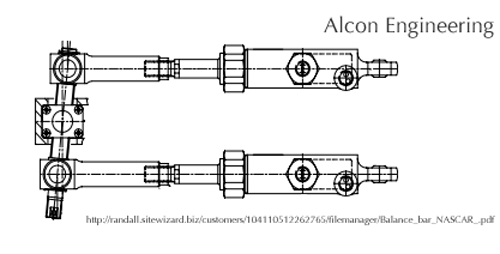In the last blog entry, I explained what brake bias was and how it could be used to improve the car’s handling during green-flag runs. This time, let’s look under the hood (or I guess, more accurately, under the dash) and see how this is accomplished.
Let’s start with the schematic from last time:

On the left side of the drawing is a threaded rod – the bias bar (running up and down) with a center pivot point and two rods (one at either end) that are used to apply force to the two master cylinders.
The next picture shows the entire pedal box assembly for a Rally Car.
When you press on the brake pedal, the bias bar moves to the right, which increases the pressure on the master cylinders. When the bias bar is perfectly centered, meaning that the distance from the center to the left rod and the distance from the center to the right rod are equal, then the force is applied equally to the two cylinders.
Now consider moving the center pivot to the left or the right. This changes the distances from the center to the left and right rods and tilts the bias bar (like is shown in the diagram at top). Now when you press on the brakes, the force is split between the two master cylinders differently. The side that the pivot is closer to will get a larger fraction of the force. Instead of a 50:50 split, you can get a 60:40 split, for example.
You can see in the photo immediately above that the center pivot is already adjusted slightly to the right of the picture, so the right master cylinder is going to get more of the braking force than the left one. Often, because of the inherent weight distribution of the car, the ‘neutral position’ of the brakes is biased a little toward the front or the rear.
And that’s pretty much how it’s done.
Please help me publish my next book!
The Physics of NASCAR is 15 years old. One component in getting a book deal is a healthy subscriber list. I promise not to send more than two emails per month and will never sell your information to anyone.
Discover more from Building Speed
Subscribe to get the latest posts sent to your email.





Be the first to comment